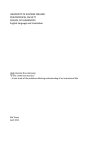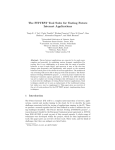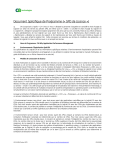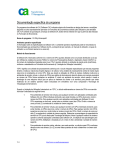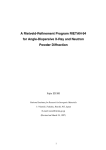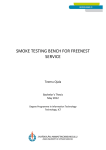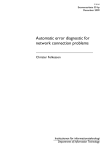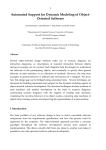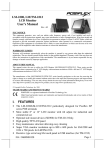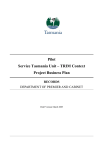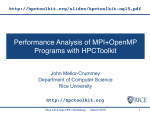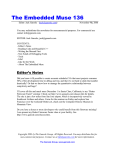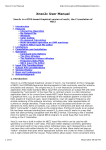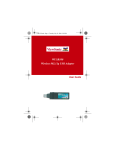Download 9. Object-oriented testing
Transcript
9. Object-oriented testing
Nowadays most of the software is designed and
implemented using object-oriented techniques.
How does testing of object-oriented systems
differ from traditional procedural programs?
Department of Software Systems
Mika Katara: Software Testing, 2011
415
• Based on [Pezzè&Young 07]
• Essentially the techniques for testing procedural programs
work also with testing object-oriented programs
• Because of the specific properties of objects some crucial
parts might remain untested
• For this reason, a number of object-specific techniques have
been developed, to help test the areas that are otherwise left
untested
• Affects testing mainly at unit and integration levels
Department of Software Systems
Mika Katara: Software Testing, 2011
416
• The pros of object-oriented systems from tester’s point of view
– Object-oriented programming has brought more attention on the
design of the programs (design patterns etc.)
• On the other hand, the same problem can be solved in very
different ways
– Methods are usually shorter than the corresponding procedures
• Usually the ”shortness” of a method means easier unit testing
• On the other hand, there might be more methods
– Test cases are potentially reusable just like the code
Department of Software Systems
Mika Katara: Software Testing, 2011
417
• The greatest difference with the testing object-oriented
programs is that an object has a state
– The behavior of the system in certain moment depends on the
inner states of its objects
– The techniques that do not take into a consideration the states of
the objects are not necessarily enough for testing an objectoriented system
– The lifecycle of an object from construction to destruction
Department of Software Systems
Mika Katara: Software Testing, 2011
418
• Another important distinction is data hiding
– Some of the attributes of an object that define its state are
hidden from external viewers
– Information hiding can improve the quality of the code and
reduce the need for testing
– One must remember to check the hidden values of the variables
when the behavior of the system is inspected
Department of Software Systems
Mika Katara: Software Testing, 2011
419
• Inheritance
– Can the child class be left untested on the basis that its parent
class has already been tested?
– The testers have to decide
• Is it necessary to develop new test cases for the methods of
the child class
• Is it necessary to run test cases of the base class again for
the child class
• Which of the methods in the child class need not be tested
Department of Software Systems
Mika Katara: Software Testing, 2011
420
• Polymorphism and dynamic binding
– The class of an object is not determined at the time of the
compilation, so the real target of a method call is decided at run
time according to the state of system
• This makes it more difficult to design and understand the
code
– Traditional techniques that assume static binding do not cover all
the possibilities of binding (behavior)
– Different binding possibilities must be tested
• Can we apply decision coverage?
– In the case of multiple calls also their possible binding
combinations should be tested
Department of Software Systems
Mika Katara: Software Testing, 2011
421
• Abstract classes
– Abstract classes may be important parts of component interfaces
or libraries, but they cannot be instantiated or tested
– Sometimes it might be impossible to know how these classes in
question are to be used in practice
– Testers must try to make educated guesses about the important
ways to use abstract classes and test accordingly
Department of Software Systems
Mika Katara: Software Testing, 2011
422
• Exceptions
– Exception mechanisms of object-oriented languages are used
frequently
– An exception can be thrown in a completely different part of the
code from where it is processed
– Dynamic binding brings in complexity of its own
– One should pay especial attention to testing exceptions
Department of Software Systems
Mika Katara: Software Testing, 2011
423
• Concurrency
– The usage of threads is encouraged or even required in objectoriented languages
• For example user interface libraries of Java
– Unfortunately concurrency is a major issue when it comes to
testing
• Usually an event A happens before event B, but is this
always true or does it depend on the scheduler?
• Does mutual exclusion work correctly in all situations?
Department of Software Systems
Mika Katara: Software Testing, 2011
424
• Objects affect testing on the lowest levels of the V-model
– Mostly in unit and integration testing
– In other phases the traditional methods work well
• As a rule of thumb it can be said that each special property
listed above should be tested separately
– An exception is testing properties that interfere with each other,
such as inheritance and behavior that depends on the state
Department of Software Systems
Mika Katara: Software Testing, 2011
425
• Unit testing
– One should not think methods as units to be tested, as their
behavior depends often on the state of the surrounding object
– Class appears to be the most suitable unit for testing
• One should remember prioritizing: not all classes are equally
important
• Classes cannot be tested without testing its methods
Department of Software Systems
Mika Katara: Software Testing, 2011
426
• Unit testing of a class
– If a class is abstract, objects for testing are instantiated from its
child classes
• If there are no child classes, they must defined only for
testing purposes
– Design test cases that test the calling of the inherited and
overridden methods
• Analyze which of the inherited methods have to be tested
again
• Analyze whether the test cases of the base class can be
used again
• Don’t forget constructors and destructors (releasing
resources)
Department of Software Systems
Mika Katara: Software Testing, 2011
427
– Gray box testing: if the behavior of a class is specified with a
state machine, design a suite of test cases based on the state
machine
• If there is no state machine specification, it might be
worthwhile to make one to ease the testing
– White box testing: Add new test cases with the help of the code
and its structure
– Design test cases that test exception handling
• Exceptions that are thrown, caught or handled by the
methods of this class
Department of Software Systems
Mika Katara: Software Testing, 2011
428
– Extend the test suite with tests that test the polymorphic method
calls that target the methods of this class
– It might be worthwhile to pay attention to the interaction within
the class
• Methods can use the same attributes
• Methods can call other methods of the same class
Department of Software Systems
Mika Katara: Software Testing, 2011
429
• Integration testing of classes
– Compare to incremental integration strategy
– Start with small clusters of classes whose size is increased
gradually
– First one must find out the dependencies between the classes
• Class A depends on class B if
– The instances of A call the methods of the instances of B
– The instances of A contain references to the instances of
B
• The inheritance relations and abstract classes can be
ignored
• Note! In case of call-backs (for example user interface
libraries) the application always depends on the library and
not vice versa
Department of Software Systems
Mika Katara: Software Testing, 2011
430
– In well-designed software the dependencies do not generally
form loops, meaning that classes of the clusters and
dependencies between them form a tree-like structure
• If there are loops, they must be disassembled by replacing a
class with a stub
– Testing is to be started from the leaf classes, which do not
depend on other classes
– Include base classes of the leaf classes, and so on, progressing
toward the root of the tree
Department of Software Systems
Mika Katara: Software Testing, 2011
431
– In every phase black box tests that test functionality are
designed/executed for the cluster
– Additionally, if necessary, white box tests are designed/executed
• For example until the required coverage is reached
– Test cases must especially test also
• Exceptions that are thrown and handled in different classes
(within the cluster)
• The polymorphic method calls between the classes of the
cluster
Department of Software Systems
Mika Katara: Software Testing, 2011
432
• The scaling of object-oriented testing based on risks
according to Pöyhönen and Stenberg (NRC)
(www.cs.tut.fi/tapahtumat/olio2002/):
– Small risk:
• 100% method coverage
– The usage of equivalence classes (legal equivalence classes)
– The usage of boundary value analysis (boundary values of
legal equivalence classes)
• Testing of essential inheritance relationships
• Dynamic binding is tested with inheritance
• While testing memory management the most important constructors
and destructors are tested
• Some parts of the code are inspected
• Static analysis of the code
• Object models are inspected informally
Department of Software Systems
Mika Katara: Software Testing, 2011
433
– With moderate risk, in addition of the previous:
• 100% method coverage
– The usage of equivalence classes (legal + illegal
equivalence classes)
• More inheritance relations
• Testing of exceptions
• Dynamic binding is tested separately
– Although not all combinations
• All constructors are tested
• Object models are inspected
Department of Software Systems
Mika Katara: Software Testing, 2011
434
– In the case of great risks, all the previous plus the following:
• 100% method coverage
– The usage of boundary analysis (boundary values of
legal + illegal equivalence classes )
• All inheritance relations are tested
• All combinations of dynamic binding are tested
• Systematic code inspections
Department of Software Systems
Mika Katara: Software Testing, 2011
435
Mock objects
• Real problems detected in the unit testing of objects:
– The replacement of dependencies with stubs can be lots of work
(databases, protocol stacks, user interfaces)
• The size of the unit under test grows
– The repeatability of tests is often weak
• Ad-hoc type of manual labor
– The system has not been designed to be tested
• Mackinnon, Freeman, Craig: ”Endo-testing: Unit testing with
Mock Objects”, XP2000
• Can be seen as intelligent stubs
Department of Software Systems
Mika Katara: Software Testing, 2011
436
• A more structured way of creating and managing the test
code that replaces the original services
• Requires the application of good o-o design conventions from
the target
– The usage of mock objects may require refactoring
• The benefits of Mock objects
– Setting of desired state is easy
– Changing the functionalities is easy
– Checking the state is easy
Department of Software Systems
Mika Katara: Software Testing, 2011
437
• An example: testing of a simple currency converter:
public class Converter_math {
public static void Eur2fim(String euros_str, PrintStream out){
double marks_d = 0.0;
try {
marks_d = Double.parseDouble(euros_str)*5.94573;
out.println(“Result: " + euros_str + " euros correspond to "
+ marks_d + " marks.");
} catch (NumberFormatException e) {
out.println(“Error in the amount of euros: " + euros_str);
}
}
}
Department of Software Systems
Mika Katara: Software Testing, 2011
438
– Main program:
public class Converter_main {
public static void main(String[] args) {
if(args.length >= 1) {
if(args[0].equals("testing")) {
test_converter_math();
} else {
Converter_math.Eur2fim(args[0], System.out);
}
} else {
System.err.println(“Usage: Give the amount of “ +
“euros to be converted as a parameter");
}
}
}
Department of Software Systems
Mika Katara: Software Testing, 2011
439
– Testing using mock objects:
public static void test_converter_math() {
MockPrintStream mock = new MockPrintStream(System.out);
// Test case 1
mock.setExpectedPrintlnCalls(1);
mock.setExpectedStringSegment(“Error in the amount of euros: "
+ “Error state");
Converter_math.Eur2fim(“Error state", mock);
mock.verify();
// Test case 2
mock.setExpectedPrintlnCalls(1);
mock.setExpectedStringSegment(“Result: 100 euros correspond to ” +
“594.573 " + "marks.");
Converter_math.Eur2fim("100", mock);
mock.verify();
}
Department of Software Systems
Mika Katara: Software Testing, 2011
440
• Application frameworks/libraries that offer different methods
and environments to use mock-objects
–
–
–
–
–
POCMock/NMock (.NET)
Mockrunner (J2EE)
EasyMock
DynaMock
…
Department of Software Systems
Mika Katara: Software Testing, 2011
441
• The developer is responsible for building the testability
– Design patterns help
– The responsibility cannot be transferred to the tools or methods
• Unit testing requires hard work and an attitude change,
especially in the beginning when the test environment has to
be set up
• Using Mock objects may result in better design of the unit
under test
Department of Software Systems
Mika Katara: Software Testing, 2011
442
Testing patterns
• The last few years have brought about testing patterns that
can be used in testing in a way similar to design patterns in
object-oriented design
• As an example self-shunt unit testing pattern
– The idea is that the object modeling the test case relays itself as
a parameter to the system under test pretending to be a ”real”
object with which the test target should communicate with
Department of Software Systems
Mika Katara: Software Testing, 2011
443
10. Testing of information security
Couple of years ago information security was of
interest to only a small group of people.
Unfortunately nowadays everyone must be
interested in it. So how should things related to it
be tested?
Department of Software Systems
Mika Katara: Software Testing, 2011
444
• Adapted from [Whittaker&Thompson 03]
• Testing of information security is important and its importance
will only grow in the future
– Computers (PC, mobile phone, PDA etc.) are commonly used to
store confidential and secret information
– Network is more and more often used to transport this kind of
information from one place to a another
– If you don’t test the information security, the criminals will do it
for you!
Department of Software Systems
Mika Katara: Software Testing, 2011
445
• As discussed before, some errors hiding in the code can
cause disturbance for example in the functionality visible to
the user, some others can cause performance issues
• In contrast, in the testing of information security the point is to
find errors that in some situations endanger the security of the
information in the system
– For example the passwords of an online bank are stored in the
cache of the web browser even if it is cleared at the end of the
session
Department of Software Systems
Mika Katara: Software Testing, 2011
446
• Software can work otherwise entirely correctly, but may still
contain errors that endanger information security
• The requirements related to information security are not yet
widely understood
– The network is filled with software made with no regard on
information security
– For example operating systems have to be updated constantly
with security patches
Department of Software Systems
Mika Katara: Software Testing, 2011
447
• Needs for security testing can be analyzed based on risk
analysis, which helps us to identify the most important issues
in protecting our data and business
• Security can and should be ensured on many levels, such as
the physical placement of the server vs. fire walls vs. user
authentication
• In Finland, public administration has provided instructions for
users and developers of information systems concerning
security issues:
http://www.vm.fi/vm/fi/16_ict_toiminta/009_Tietoturvallisuus/0
2_tietoturvaohjeet_ja_maaraykset/index.jsp
Department of Software Systems
Mika Katara: Software Testing, 2011
448
• OWASP Top 10 – 2010 (www.owasp.org)
–
–
–
–
–
–
–
–
–
–
A1 – Injection
A2 – Cross-Site Scripting (XSS)
A3 – Broken Authentication and Session Management
A4 – Insecure Direct Object References
A5 – Cross-Site Request Forgery (CSRF)
A6 – Security Misconfiguration (NEW)
A7 – Insecure Cryptographic Storage
A8 – Failure to Restrict URL Access
A9 – Insufficient Transport Layer Protection
A10 – Unvalidated Redirects and Forwards (NEW)
Department of Software Systems
Mika Katara: Software Testing, 2011
449
• Information security is about keeping secrets
• Typical concerns related to information security are for
example:
– I want to sell my software for a good price and make sure that no
one can make illegal copies of it
– I want only specific people to get their hands on certain parts of
the software (access control)
– I want to protect my server software (and still allow the execution
of code uploaded by the user)
– I want to keep the information used by my software secret on the
disk, in memory and when transmitted over a network
Department of Software Systems
Mika Katara: Software Testing, 2011
450
• Unlike in traditional testing, specifications are less useful in
testing information security
• Instead of testing whether the software fulfills its specification,
one should examine more closely
– What side effects the implementation allows
• As a result of buffer overflow foreign code might be executed
– How does the software interact with its environment
• Operating system calls, network traffic etc.
Department of Software Systems
Mika Katara: Software Testing, 2011
451
• The threats that come through the user interface
– The protection of the user interface from unauthorized users for
example with a password
• Does the user identification work properly?
• Are weak passwords accepted?
– Is e.g. username accepted as a password?
• If a user may access only some of the information (for
example a home directory in a multiuser operating system)
do the restrictions work correctly?
Department of Software Systems
Mika Katara: Software Testing, 2011
452
• Can one obtain confidential information for example by using
the copy/paste or screen capture features?
• Is it possible to input illegal inputs such as too long strings?
– A result can be for example a buffer overflow, which can
lead to execution of foreign code
– The system may also crash, which can mean a denial of
service, that is the services offered by the system
become unavailable
Department of Software Systems
Mika Katara: Software Testing, 2011
453
• Threats coming through the file system
– The connections of the software to the file system are often
poorly tested
– Yet secrets such as passwords, license keys, etc. are saved in
files
– In the Windows world, the registry is an especially bad place to
save secrets
• In the Unix world the same naturally applies to configuration
files of programs (.emacs, etc.)
– Fuzz testing based on file formats can used to test the
robustness of the implemented file operations
Department of Software Systems
Mika Katara: Software Testing, 2011
454
• Threats coming through the operating system
– If the program contains within its memory encrypted secret
information, this is often safe; problems appear when information
is handled unencrypted
– If the resources of the operating system run low, such as the
amount of available memory, the result may be for example
• Denial of service
• Uncontrolled crashing of the program
– Can secret information be dumped to a hard drive in an
unencrypted form?
Department of Software Systems
Mika Katara: Software Testing, 2011
455
• The threats coming through other software
– Programs make more and more use of other programs through
different interfaces
– What happens if another program becomes a victim of an attack
or crashes?
– The tester has to find out the connections to other programs and
identify situations where these might cause threats
– For example, when communicating through a network one
should make sure the program functions correctly with illegal
packets, too short and too long packet frames etc.
• Fuzz testing is also needed here
• Similar worries are related to regular interfaces
Department of Software Systems
Mika Katara: Software Testing, 2011
456
• Protecting the software itself
– Sometimes the program contains algorithms, etc. that give an
competitive edge
– In such a case it might be sensible to protect against reverse
engineering trying to figure out the contents of the code using
e.g. a disassembler
Department of Software Systems
Mika Katara: Software Testing, 2011
457
• Often the attack may come from many fronts at the same time
– For example blocking access to some library and sending an
illegal input through the user interface at the same time
• Sometimes built-in ”features” of the program might offer holes
in security
– Instrumented test code may have been forgotten in the binary
code, offering ready hooks for running test cases
• A developer of a single component might have been ignorant
of the whole the component belongs to
– If for example the data relayed as a parameter is secret, it must
not be written to disk unencrypted even temporarily
Department of Software Systems
Mika Katara: Software Testing, 2011
458
Example attacks
• Block the calls of a application to the (dynamic) libraries
– A tool is used to observe which libraries the application calls in
which situation and the calls to a certain library are blocked
– The purpose is to test that an application does not endanger
information security even if the library is not available
Department of Software Systems
Mika Katara: Software Testing, 2011
459
– Often application developers assume that libraries are always
available
• This is an exceptionally dangerous assumption if a library
function is used to ensure something related to information
security (for example user privileges)
• If a call is made to a blocked library function, the result is
generally the start of exception handling
– Often exception handlers are not tested as carefully as
other code
Department of Software Systems
Mika Katara: Software Testing, 2011
460
• The result may be a crash of the application or the dumping
of secret information to the screen or disk
• The application may also seem to continue to function
normally, even though the service provided by the library
function is not available
– This can be a sign of the program leaving a return value
unchecked, for example
– The result may even be the granting of incorrect
privileges to the user
Department of Software Systems
Mika Katara: Software Testing, 2011
461
• Look for suspicious options and their combinations
– Testing the options that can be given through both the command
line and the graphical user interface is difficult because of the
large number of combinations
– If one concentrates only on the most essential options for the
user, it is possible that as a result the applications runs partly
untested code
– One should look for combinations of options whose synergy may
compromise information security
– If the software in question is a new version of an old program,
one should examine the previous version and its documentation
Department of Software Systems
Mika Katara: Software Testing, 2011
462
• If an option has disappeared from the documentation of the
new version, test if the implementation still supports it and if it
does, does it work safely
– User input might only be verified for some of the options
• If an application asks for an address, and country can be
selected from preselected set of countries using a menu, the
checking of a postal code might depend on which country is
selected
– A program might accept an overly long postal number
that might contain control symbols…
» Would it be possible to input SQL-queries and
execute them?
– Or is the postal code checking algorithm implemented
also for the addresses of Ivory Coast?
Department of Software Systems
Mika Katara: Software Testing, 2011
463
• Port scanning
– Applications that use network must protect themselves against
port scanning
– A port scanner is used as a help for testing
– The usage of application specific ports should especially be
tested (numbers 1024-65535)
– If an application is trying to hide an open port by returning an
error message, the message must be of the standard format so
as not to raise suspicion
Department of Software Systems
Mika Katara: Software Testing, 2011
464
• Find alternative ways to do the same thing
– How many different ways are there to open a Word document in
Windows?
– Have all the ways been tested and shown to be safe?
– The authors of the book ”How to break software security” found a
security hole in Windows XP in the following way:
Department of Software Systems
Mika Katara: Software Testing, 2011
465
• Because Windows Explorer can be used for many same purposes
as Internet Explorer, let's read emails with IE using MS Exchange
Server’s Outlook Web Access interface so that first IE is started
through WE.
• After the session we close the WE and IE windows
• Next we contact the email server with WE and what do you know,
we get in without a password query!
• When we try to read individual messages with a separate window
the password is asked, but when using the preview of Outlook, the
password is not asked
• The lesson: Information security was breached when an optional
way to do the same thing was used
– Replaced Internet Explorer with Windows Explorer
– Replaced an Outlook window with a preview
• Note! This bug has since been fixed
Department of Software Systems
Mika Katara: Software Testing, 2011
466
• Problems of testing of information security
– Testing has to find all the security holes in the software, the
intruder needs only one
– The errors related to information security are usually much less
noticeable than for example functionality or performance issues
Department of Software Systems
Mika Katara: Software Testing, 2011
467
11. Static testing
The tool chest of a tester and a quality
assurance professional contains techniques that
complement each other. In the following we
present some group work techniques, as well as
discuss automatic code analysis.
Department of Software Systems
Mika Katara: Software Testing, 2011
468
11.1 Inspection
• Composed from the source: Ahtee, Haikala, Märijärvi:
Inspection (training material, in Finnish)
• Inspection – IEEE 610.12-1990 (Standard Glossary of
Software Engineering Terminology):
– A static analysis technique that relies on visual examination of
development products to detect errors, violations of development
standards, and other problems
– Types of inspections include code inspection, design inspection
•
•
•
•
Internal inside a project, 3-6 participants
Very formal compared to other group working techniques
Flexible scheduling, multiple inspections during the project
Only small artifacts are inspected at a time
Department of Software Systems
Mika Katara: Software Testing, 2011
469
• Fagan developed the technique at IBM in the 1970’s
• Inspections are considered the most effective technique for
quality assurance
• Inspections support the process and project in the following
ways
– By trying to remove the errors at the earliest possible stage
– By making the progress in the project visible
• An accepted inspection corresponds to reaching of a
milestone
– By sharing information to multiple persons
Department of Software Systems
Mika Katara: Software Testing, 2011
470
• An inspection takes at least two hours, during which at most
– 50 pages of a document or
– 500 lines of code
•
•
•
•
can be inspected
50-80% of errors are found
Inspection consume about 5-15 % of the work time
Very cost effective!
Although the method does not add very much to the workload,
commitment from the management is needed
Mika Katara: Software Testing, 2011
Department of Software Systems
471
• Inspections in the software process
Doing it right the first time
Specification
(Phase product n-1)
Department of Software Systems
Do
Draft
Inspect
OK
Phase product n
Rework
Mika Katara: Software Testing, 2011
472
• Inspection can be applied to following artifacts, for instance
–
–
–
–
–
–
–
–
An offer, an agreement
Functional specification
Project plan
Technical specification
Test plan
Code
Document that is be delivered to the user (manual)
Study material
Department of Software Systems
Mika Katara: Software Testing, 2011
473
• Roles in a inspection meeting
–
–
–
–
–
A chairman
The author of the phase product
Secretary = often the author
Inspector = everyone
Reader
• Can be the author
• Only in the code inspections
– An expert of the area of the application, for example a specialist,
user experience specialist, proof-reader, testing expert, etc.
• Someone can focus on checking the memory management,
somebody else can check loops, algorithms, interfaces, etc.
Department of Software Systems
Mika Katara: Software Testing, 2011
474
• Rules of thumb
– If everything cannot be inspected, only the most important parts
are inspected
– Careful preparation is important
• The material to be inspected has to be given out to the
inspectors 3 days before the inspections
• The inspection meeting should be canceled, if there are no
prerequisites for its success
– For example phase product is too incomplete
– The product is always under evaluation, not its author
– The goal is to find new problems – not solving them
– The fixes for cosmetic errors can be delivered to the secretary
after the inspection meeting
Department of Software Systems
Mika Katara: Software Testing, 2011
475
• One should consider the rules that facilitate the inspection
– For example “does the requirement really consider the real need
of the customer”
• The rules should be considered carefully according to the
artifact, organization, process, risks, etc.
– With just a few rules one can reach good results (Marko Komssi,
EuroSTAR 2004)
– The accuracy of the rules can be increased as the process
matures
• At IBM they have develop a new version of inspections that
does require preparation:
E. Farchi, S. Ur: “Selective Homeworkless Reviews”, Proceedings of the 2008
International Conference on Software Testing, Verification, and Validation IEEE
Computer Society Washington, DC, USA
Department of Software Systems
Mika Katara: Software Testing, 2011
476
• The maturity levels of inspections
–
–
–
–
–
Inspections are held
Some benefit from inspections
Inspections are effective
Statistics are collected from inspections
Bug analyses and checklists are produced
according to the experiences
– The collected information is used for improving
the inspection and the software processes
Department of Software Systems
Useful for the
project
Useful for
the organization
Mika Katara: Software Testing, 2011
477
11.2 Review
• Review or a technical review
• IEEE 610.12-1990:
– A process or meeting during which a work product, or set of work
products, is presented to project personnel, managers, users,
customers, or other interested parties for comment or approval.
Types include code review, design review, formal qualification
review, requirements review, test readiness review.
• Is used for ending a phase
– For example functional or technical specification phase
• A formal check to see if all the ending requirements of the
phase have been met
• The goal is to make the advancement of the project visible
– The goal is consensus, not so much bug finding
Department of Software Systems
Mika Katara: Software Testing, 2011
478
• Reviews and inspections of the project [Haikala&Märijärvi 06]:
Pre-study&
the deal
Functional specification
Technical specification
Inspection
Programming and module testing
Review, internal
Integration
Review, with a client
System testing
time
Department of Software Systems
Mika Katara: Software Testing, 2011
479
• Note! The terminology is not consistent: in some cases
inspections are called reviews, or vice versa
• Because these are fundamentally different techniques, it is
worthwhile to find out beforehand whether the goal is to
inspect or review
Department of Software Systems
Mika Katara: Software Testing, 2011
480
11.3 Walkthrough
• IEEE 610.12-1990:
– A static analysis technique in which a designer or programmer
leads members of the development team and other interested
parties through a segment of documentation or code, and the
participants ask questions and make comments about possible
errors, violation of development standards, and other problems.
• Code walkthrough with the purpose of finding errors
• The developer explains what he thinks the program does
Department of Software Systems
Mika Katara: Software Testing, 2011
481
• Walkthrough compared to the inspection
–
–
–
–
–
Emphasizes the role of the developer in the event
Is less formal
Requires less training
Finds fewer errors
Is usually less cost effective
Department of Software Systems
Mika Katara: Software Testing, 2011
482
11.4 Static code analysis
• Idea: To analyze the source code automatically without
executing it
• The purpose is
– To find errors from the code
– To notice deviations from the normal coding conventions (style
guides)
– To generate documentation of the code
– To calculate values for metrics of the program such as the
length, complexity
Department of Software Systems
Mika Katara: Software Testing, 2011
483
• The techniques to be used are based mostly on information
and control flow analysis, constraint solving, etc.
• The first static code analysis tool introduced for the greater
audience was Lint that came with UNIX
• The purpose of Lint was to find typical errors from C code that
the compilers of that time did not detect
Department of Software Systems
Mika Katara: Software Testing, 2011
484
• What kind of errors can be found?
• For example
–
–
–
–
–
–
–
Syntax errors
Same code in multiple places, dead code (never executed)
Maintenance and portability problems
Uninitialized variables
Unused return values
Misuse of pointers
Buffer overflows, other information security issues
Department of Software Systems
Mika Katara: Software Testing, 2011
485
• Well-known static analysis tools:
–
–
–
–
–
PC-Lint, Coverity, PolySpace, KlocWork
Usually costly (except the first one)
Scalability can become an issue
The number of false alarms might also become an issue
Can prove valuable very quickly by finding errors in critical code
Department of Software Systems
Mika Katara: Software Testing, 2011
486
• Where to find help for documentation?
• For example:
– Javadoc style API-documentation
– Doxygen style graphical model (UML) of the software
• www.doxygen.org
– Call hierarchy
bar1()
foo()
bar2()
Department of Software Systems
Mika Katara: Software Testing, 2011
487





































